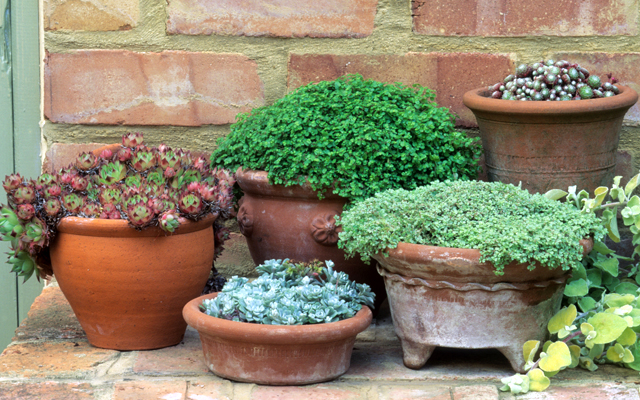How to choose pots for your plants
Big can be best when it comes to choosing the right pots for your plants, says Alan Titchmarsh


As an addict of the television programme Grand Designs, I’m always a little disappointed in the fact that the area surrounding the ambitious constructions be they of traditional or modernist style are almost always left unkempt by the time of the ‘reveal’.
It’s understandable; the owners, having spent all their energies (and always a far greater amount of money than they budgeted for), need to get their breath back before tackling the landscape. And yet, when they do make a bit of an effort, they invariably opt for a few containers on the beautifully constructed terrace that now surrounds their property.
At that moment, for some unknown reason, their good taste and sense of proportion seem to fly out of the window. Big pots, little pots, plastic pots and those of brightly coloured ceramics sit side by side with little thought given to scale, proportion and style in relation to the property itself.
What do you suppose has happened? Have the owners exhausted their imaginations along with their bank balance? It seems the only explanation. But it points up the importance of container style in relation to property something we all need to remind ourselves of from time to time.
For a start, less is more. And big is best. Small containers usually have less impact and they also require watering on a wearyingly regular basis twice a day at least in hot weather. The larger the pot, the more slowly the compost within it will dry out an important consideration if you’re out all day. Other practical considerations need to be borne in mind, too.
I love terracotta ‘long-toms’ planted up with domes of lavender, but, in high winds, they blow over and smash, so I’ve resorted, instead, to tapered square tubs of zinc (narrower at the bottom than the top) which are less fragile and which complement the grey and purple of Imperial Gem lavender. I now plant this in preference to Hidcote its habit and richness of flower colour seem to have the edge over that old favourite.
Lead tubs are best of all in terms of durability and anchorage (nothing short of a Force 12 gale would even shake them). Camellias (which I have to grow in containers of ericaceous compost, thanks to my chalky soil) do well in them, even when they grow large and put up quite a ‘sail’. I’ve never had one of them blow over. But lead is expensive and the newer kind of ‘faux lead’ containers that are lighter in both weight and price are hard to distinguish from the real thing, especially if the lip (where the glass-fibre fabrication is most obvious) is disguised with a mulch of gravel or pebbles.
Exquisite houses, the beauty of Nature, and how to get the most from your life, straight to your inbox.
When it comes to choosing a planting medium, I like to use a mixture of John Innes No.2 and peat-free multipurpose compost, the combination of the two offer- ing the ideal medium. The John Innes provides welcome weight, for stability, and hangs on to its nutrients longer, but the addition of multipurpose compost leavens the loam and prevents it becoming rock hard. Monthly feeding between June and September helps keep all plants in tip-top condition.
As to the inhabitants, that’s entirely up to you, but I like statement foliage plants such as palms, tetrapanax and fatsia, which, to my eye, often provide visual impact more effectively than a mixture of summer bedding. That said, in spring, nothing beats a generous planting of single-colour tulips. Which reminds me, bulbs really need to be ordered now, to be sure of getting the variety you desire.
* This article was first published in Country Life on August 20 2014 * Follow Country Life magazine on Twitter
